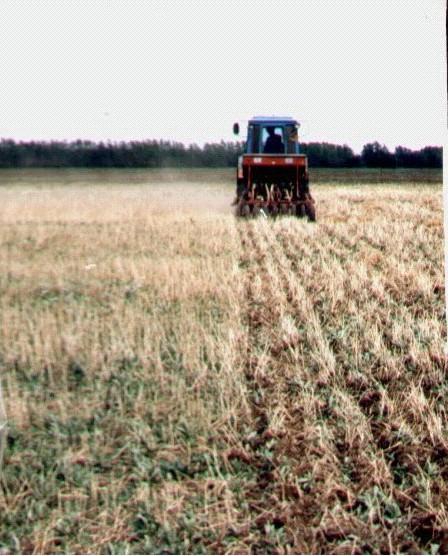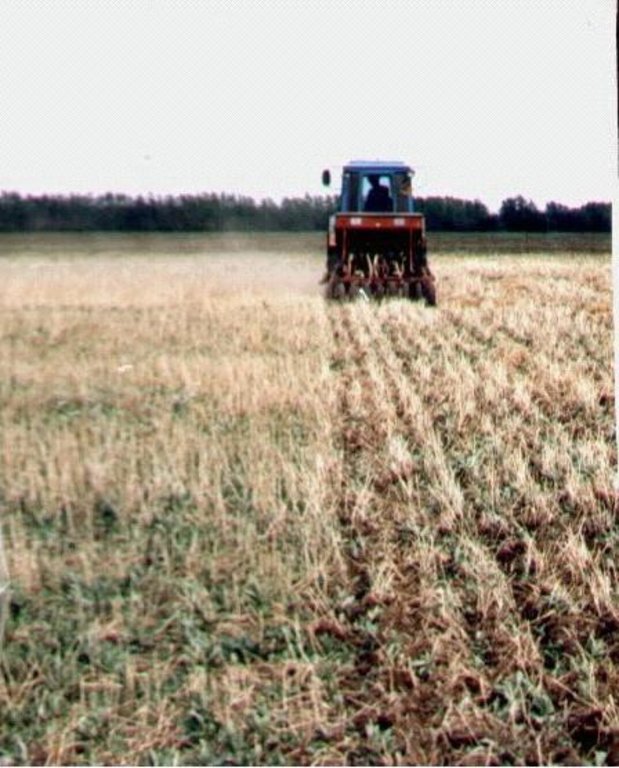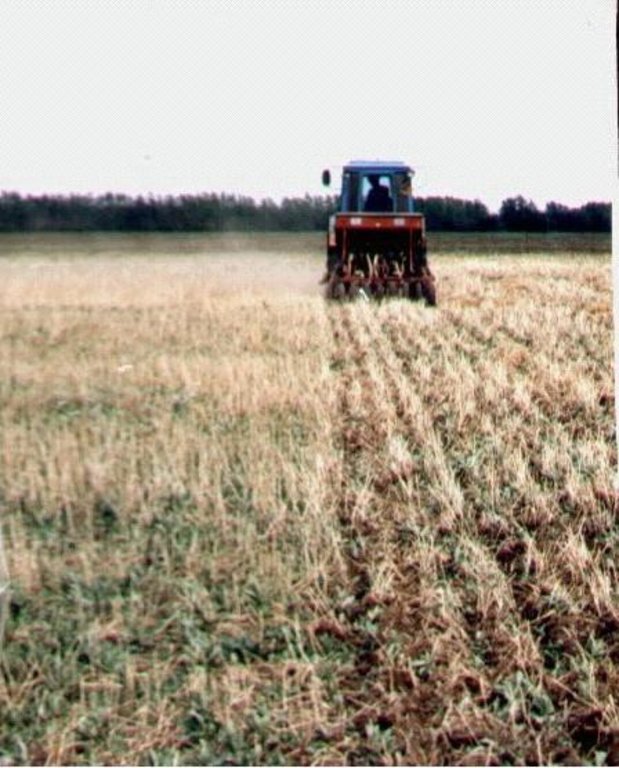Crop on the stubble background [Kazakhstan]
- Creation:
- Update:
- Compiler: Ervin Gossen
- Editor: –
- Reviewer: Fabian Ottiger
approaches_2363 - Kazakhstan
View sections
Expand all Collapse all1. General information
1.2 Contact details of resource persons and institutions involved in the assessment and documentation of the Approach
1.3 Conditions regarding the use of data documented through WOCAT
The compiler and key resource person(s) accept the conditions regarding the use of data documented through WOCAT:
Yes
1.4 Reference(s) to Questionnaire(s) on SLM Technologies
2. Description of the SLM Approach
2.1 Short description of the Approach
Stubble crop for cultivation of grain crops (spring wheat).
2.2 Detailed description of the Approach
Detailed description of the Approach:
Aims / objectives: Crop on the stubble includes. 1) In the spring May 15-25, without special preparations that is on stubble, crop of grain crops is made. 2) Crop is made by stubble seeder. 3) Depth of closing up of seeds of 6-8 centimeters. 4) Norm of seeding is 180 kg per 1 ha. 5) Productivity on stubble is 11,5 centner/ha. The given approach prevents crops from wind and water erosion, goes moisture accumulation in a soil cover and accumulation of organic. Problem of soil degradation is especially sharp in North Kazakhstan, zone of the grain agriculture. For the period of the long-term plugging of virgin land the content of humus has decreased by 5-20% and more. 1.2 billion tons or 28.3% from 4.3 billion tons of the humus stocks of the arable layer (0-25 sm) are irrevocable lost because of mineralizing the organic substance, subtraction with a crop, water and wind erosion. In 70th years in Kazakhstan have developed and introduced soil-protective system of agriculture due to wich has been stopped soils erosion and also the productivity is essentially increased. Before introduction of soil-protective system the productivity in northern Kazakhstan made of 5-7c/ha. After introduction of soil-protective system of agriculture the productivity has raised up to 12-15 c/ha. One of the elements of soil-protective system of agriculture ??¡§ are crop on stubble. In the conditions of Kazakhstan, the plowing and crop should be carried out with preservation of stubble in a fallow field once for rotation. It promotes preservation and rational use of the vegetative rests and moisture reduction of industrial expenses and also increase in productivity of grain crops.
2.3 Photos of the Approach
2.5 Country/ region/ locations where the Approach has been applied
Country:
Kazakhstan
Region/ State/ Province:
Northern Kazakhstan
2.6 Dates of initiation and termination of the Approach
Indicate year of initiation:
1976
2.7 Type of Approach
- traditional/ indigenous
2.8 Main aims/ objectives of the Approach
The Approach focused on SLM only (Herbicides, moisture accumulation, crop rotation)
Prevention of wind and water erosion of soils, increase in productivity of grain crops in a steppe zone of Kazakhstan, preservation of moisture accumulation.
The SLM Approach addressed the following problems: Prevention of water and erosion on an arable land.
2.9 Conditions enabling or hindering implementation of the Technology/ Technologies applied under the Approach
social/ cultural/ religious norms and values
- hindering
Treatment through the SLM Approach: Shortage of financial assets.
availability/ access to financial resources and services
- hindering
Cooperation of farms.
Treatment through the SLM Approach:
legal framework (land tenure, land and water use rights)
- enabling
The existing land ownership, land use rights / water rights moderately helped the approach implementation: The property rights to the ground promote more operatively to make decision at land users on introduction of the approach
- hindering
The old worn out park of the agriculture technique.
Treatment through the SLM Approach:
knowledge about SLM, access to technical support
- hindering
The cooperative approach of farmers to use of technique.
Treatment through the SLM Approach:
3. Participation and roles of stakeholders involved
3.1 Stakeholders involved in the Approach and their roles
- local land users/ local communities
Working land users were mainly men (Assosiation of separate farms where the basic volume of agriculture works are carried out by men)
Men participated basically. Work cycles of a grain husbandry are served by men
- local government
- national government (planners, decision-makers)
Institutions of local government
3.2 Involvement of local land users/ local communities in the different phases of the Approach
| Involvement of local land users/ local communities | Specify who was involved and describe activities | |
|---|---|---|
| initiation/ motivation | passive | public meetings; Meetings of farmers |
| planning | passive | workshops/seminars; Popularization of the approach |
| implementation | self-mobilization | responsibility for major steps; Personal interest of farmers |
| monitoring/ evaluation | none | |
| Research | none |
3.4 Decision-making on the selection of SLM Technology/ Technologies
Specify who decided on the selection of the Technology/ Technologies to be implemented:
- mainly SLM specialists, following consultation with land users
Explain:
Necessity for preservation of fertility of the grounds and struggle against erosion.
Decisions on the method of implementing the SLM Technology were made by mainly by land users supported by SLM specialists. Introduction
4. Technical support, capacity building, and knowledge management
4.2 Advisory service
Do land users have access to an advisory service?
Yes
Specify whether advisory service is provided:
- on land users' fields
Describe/ comments:
Recommendations on system of conducting of an agri; Key elements: Distribution of methodical manuals, Distribution of agromelioratives directories; 1) Advisory service was carried out through: By personal contact 2) Target groups for extension: land users; Activities: Seminars, conversations, joint introductions of the approach
Advisory service is inadequate to ensure the continuation of land conservation activities; The state structures and services of training are not present
4.3 Institution strengthening (organizational development)
Have institutions been established or strengthened through the Approach?
- yes, greatly
Specify the level(s) at which institutions have been strengthened or established:
- local
Specify type of support:
- equipment
4.4 Monitoring and evaluation
Is monitoring and evaluation part of the Approach?
Yes
Comments:
bio-physical aspects were regular monitored through observations
economic / production aspects were regular monitored through observations
ecological aspects were regular monitored through observations
There were few changes in the Approach as a result of monitoring and evaluation: The methodical approach remains constant. Changes have been brought in a technological part the design of a seeder was improved.
4.5 Research
Was research part of the Approach?
Yes
Specify topics:
- economics / marketing
- ecology
- technology
Give further details and indicate who did the research:
1.Selection of grades of the grain crops. 2.Designing and creation of technique (seeders SZS-2). 3.Development of recommendations on conducting a grain husbandry in dried steppe and steppe zone.
Research was carried out both on station and on-farm
5. Financing and external material support
5.1 Annual budget for the SLM component of the Approach
If precise annual budget is not known, indicate range:
- < 2,000
Comments (e.g. main sources of funding/ major donors):
Approach costs were met by the following donors: government (national): 100.0%
5.2 Financial/ material support provided to land users
Did land users receive financial/ material support for implementing the Technology/ Technologies?
Yes
5.3 Subsidies for specific inputs (including labour)
- equipment
| Specify which inputs were subsidised | To which extent | Specify subsidies |
|---|---|---|
| machinery | partly financed | |
5.4 Credit
Was credit provided under the Approach for SLM activities?
No
6. Impact analysis and concluding statements
6.1 Impacts of the Approach
Did the Approach help land users to implement and maintain SLM Technologies?
- No
- Yes, little
- Yes, moderately
- Yes, greatly
The approach considerably reduces erosion of the grounds
Did other land users / projects adopt the Approach?
- No
- Yes, little
- Yes, moderately
- Yes, greatly
The given approach is component of SWC on the minimal soil tillage
6.3 Sustainability of Approach activities
Can the land users sustain what has been implemented through the Approach (without external support)?
- yes
6.4 Strengths/ advantages of the Approach
| Strengths/ advantages/ opportunities in the land user’s view |
|---|
| Maintenance of guaranteed crops (How to sustain/ enhance this strength: The same) |
| Maintenance of guaranteed incomes (How to sustain/ enhance this strength: The same) |
| Increase of fertility of the grounds (How to sustain/ enhance this strength: Regular application of SWC approaches) |
| Reduces danger of display of water and wind erosion (How to sustain/ enhance this strength: Regular application of SWC approaches) |
| Strengths/ advantages/ opportunities in the compiler’s or other key resource person’s view |
|---|
| Provides a guaranteed crops (How to sustain/ enhance this strength: Ecological propagation and education) |
| Increase of fertility of the grounds (How to sustain/ enhance this strength: To expand the areas of application of SWC approach) |
| Decrease of eroded lands (How to sustain/ enhance this strength: To expand an area of application of SWC approach) |
6.5 Weaknesses/ disadvantages of the Approach and ways of overcoming them
| Weaknesses/ disadvantages/ risks in the land user’s view | How can they be overcome? |
|---|---|
| Ecological limitation of SWC approach | Investments are necessary |
| Weaknesses/ disadvantages/ risks in the compiler’s or other key resource person’s view | How can they be overcome? |
|---|---|
| Lack of means at small farmers | Cooperation of farms and infusing of investments |
7. References and links
7.1 Methods/ sources of information
- field visits, field surveys
- interviews with land users
7.2 References to available publications
Title, author, year, ISBN:
Gossen E.F. Without rotation of layer, Almaty 2000 ySoil-protective agriculture Baraev A.I., Moscow 'Floc' 1975 y
Available from where? Costs?
SPC for Grain Husbandry of the Baraev???s name 15$SPC for Grain Husbandry Baraev A.I. 10$
Title, author, year, ISBN:
Soil-protective agriculture Baraev A.I., Moscow 'Floc' 1975
Available from where? Costs?
SPC for Grain Husbandry Baraev A.I. 10$
Links and modules
Expand all Collapse allLinks
No links
Modules
No modules




